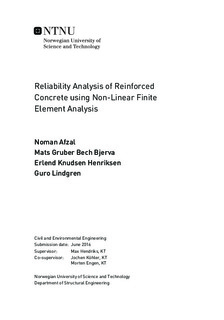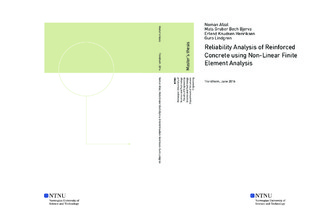| dc.description.abstract | The purpose of the thesis is to investigate methods that may be used for assessing the
reliability in large concrete structures in combination with non-linear nite element analyses
(NLFEA).
Reliability methods are applied to a simple beam with various lengths, and evaluated with
respect to applicability, accuracy and feasibility. The reliability is assessed by a response
surface method in combination with a rst order reliability method (RSM-FORM), and
a small-sample Monte Carlo type using Latin hypercube sampling with curve tting to
a normal distribution (LHS-t). For greater insight, these methods are investigated using
both NLFEA and analytic limit state function evaluations (LSFE). Analytic Monte
Carlo simulations are used as benchmarks. For very strong or weak material parameters,
NLFEA yield inconsistent results. Only two stochastic variables are introduced, namely
the concrete in-situ compressive strength and the steel yield strength. Thus, only material
uncertainties are implemented in the reliability assessments. Since load eects are treated
deterministically, this study only regards reliability of the resistance.
In the region where NLFEA is consistent and when only bending failure mode is prevalent,
results from NLFEA RSM-FORM yield quite similar results compared to the benchmarks.
Similarly, NLFEA LHS-t provides decent, conservative results although less accurate
than RSM-FORM. Analytic results show two important ndings: (1) RSM-FORM accuracy
decreases with two failure modes, and (2) the choice of distribution seems important
for LHS-t, however an optimal choice may still not provide as accurate results as RSMFORM.
RSM-FORM shows promising results for a simple beam with one failure mode. However,
for large concrete structures with several failure modes, this method might struggle to
create an accurate response surface. This is further impeded by the diculties in producing
consistent NLFEA response. In terms of feasibility, RSM-FORM normally requires
10-25 LSFEs for one reliability assessment, while LHS-t with 50 LSFEs provide the full
picture of the structural reliability. LHS-t is not as accurate as RSM-FORM, however, it
is simpler to grasp and results show that it provides reasonable accuracy for preliminary
reliability assessments.
The literature provides a variety of optimizations and improvements on the methods,
which might increase their applicability for large scale reliability assessments. Results
herein are promising, and should be further investigated on more complex models using
improved RSMs found in the literature. | |

